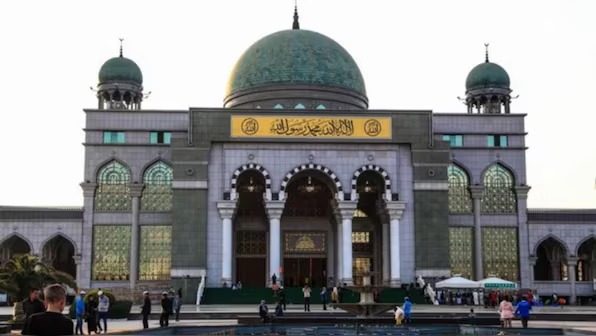The last major Arabic-style mosque in China has lost its dome and had its minarets radically modified raising concerns about the growing intolerance in the country. The recent modifications are part of the Chinese government’s campaign to sinicise the country’s Muslim places of worship.
The mosque in question is the Grand Mosque of Shadian which is touted as China’s biggest and grandest Muslim place of worship. The mosque towers over the small town from which it takes its name and is located in the southwestern Yunnan province.
As per the reports, until last year, the building was graced by a tiled green dome and adorned with a crescent moon. It was also flanked by four smaller domes and soaring minarets. In 2022, the entrance pavilion was decorated with a large crescent moon and star made from vivid black tiles.
What are the new changes?
The latest satellite photographs and witness accounts obtained by The Guardian show that the dome has been removed and replaced by a Han Chinese-style pagoda rooftop. The minarets of the mosque, on the other hand, have been shortened and converted into pagoda towers.
There’s only a faint trace of the crescent moon and star tiles that once marked the mosque’s front terrace.
This is not the first case of a mosque being modified according to Chinese propaganda. Yunnan’s other landmark mosque, Najiaying, which is less than just 100 miles from the Shadian mosque also faced a similar ordeal.
In 2018, the Chinese government published a five-year plan which dealt with the “sinification of Islam”. One of the major parts of the plan was to resist “foreign architectural styles” and to promote “Islamic architecture … that is full of Chinese characteristics”.
Not only this, a leaked Communist party memo showed that the local authorities were instructed to “adhere to the principle of demolishing more and building less”.
“Sinification of these two landmark mosques marks the success of the campaign. Even if there are small mosques left of Arab style in villages, it will be difficult for local communities to contest their sinicisation,” Ruslan Yusupov, an anthropologist at Cornell University told The Guardian.
Hannah Theaker, a historian of Islam in China at the University of Plymouth, said the mosque sinicisation campaign had progressed “province by province”. The Yunnan province which is one of the furthest provinces from Beijing was actually tackled last.
“By 2023, there was a sense among communities that architectural sinicisation would reach the famous Yunnanese mosques, as the last major unsinicised mosques in China,” Theaker furthered.
Ma Ju, a Chinese Hui living in New York insisted that the renovations were “a clear message to destroy your religion and your ethnicity”.
The history of the Grand Mosque of Shadian
The grand mosque was first built during the Ming Dynasty and was destroyed during the Cultural Revolution. In an uprising, known as the Shadian incident, the People’s Liberation Army suppressed the Hui Muslims in the area.
Over 1,000 people were killed in the tragic incident. The mosque was later rebuilt and expanded with the help of the Chinese government. It is pertinent to note that the mosque was designed based on the Prophet’s Mosque in Medina, Saudi Arabia, where Muhammad is believed to be buried.
The building comprises three prayer halls and a capacity for 10,000 worshippers. The Hui Muslims are an ethnic minority in China and have a similar population size to Uyghurs.









































